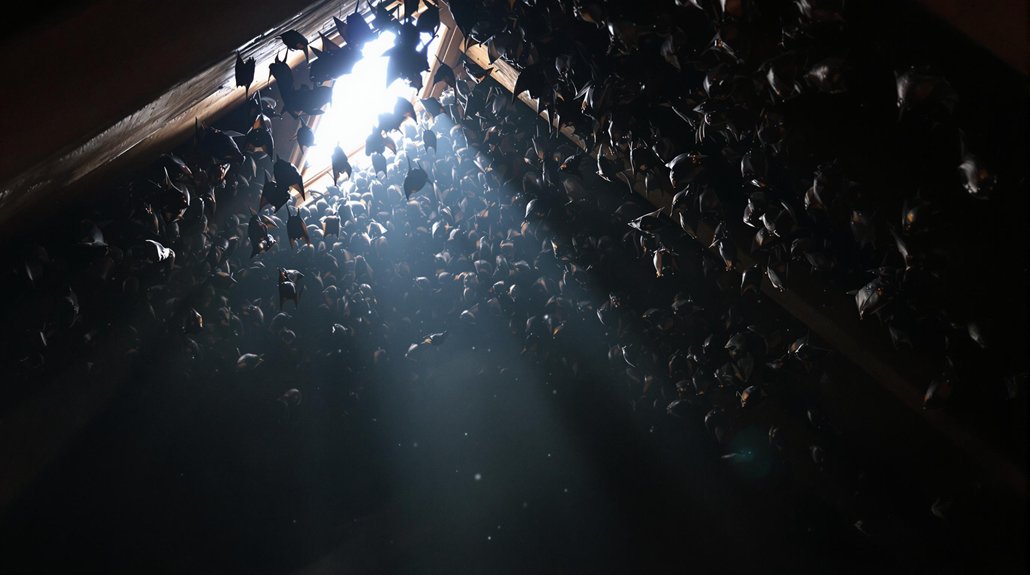A bat infestation is quite serious. Bats can transmit diseases like rabies and create respiratory issues through their droppings, known as guano. Structural damage is also a concern, as bat waste can weaken insulation and wiring, leading to costly repairs. Additionally, legal regulations govern the management of bat removal, which can complicate matters for homeowners. Signs of an infestation include droppings, unusual noises, and visual sightings of bats. Understanding these risks and prevention strategies is essential for home safety. Further insights into managing bat infestations can offer valuable guidance.
Key Article Highlights
- Bat infestations pose health risks, including rabies transmission and respiratory illnesses like histoplasmosis from guano exposure.
- Structural damage from bat droppings can weaken supports and harm insulation, leading to costly repairs and increased energy bills.
- Legal regulations often restrict bat removal methods, making compliance essential to avoid fines and ensure safe management.
- Signs of infestation include droppings, nocturnal noises, and visible entry points, necessitating regular inspections for early detection.
- Professional assistance is recommended for safe bat removal and to ensure compliance with wildlife regulations post-infestation.
Risks to Human Health
Understanding the risks to human health posed by a bat infestation is essential for homeowners. Bats can carry various diseases that may be transmitted to humans. One of the most concerning is rabies, a viral infection that affects the nervous system and can be fatal if not treated promptly. Although rabies transmission is rare, any contact with an infected bat is a serious matter.
In addition to disease transmission, bat droppings, known as guano, can lead to health issues. When guano accumulates, it can produce a fungus that may cause histoplasmosis, a respiratory illness. This can be particularly dangerous for individuals with weakened immune systems.
Furthermore, bat infestations can trigger allergy reactions in some people. The proteins found in bat saliva, urine, and feces can cause allergic responses, leading to symptoms such as sneezing, itching, and respiratory distress.
Structural Damage Concerns
Bat infestations can pose significant risks to property integrity. Their droppings and nesting materials can damage insulation and wiring, leading to costly repairs. Addressing these concerns promptly is essential to prevent further structural issues.
Property Integrity Risks
While many may underestimate the impact of a bat infestation, the reality is that it can pose significant risks to property integrity. Bats can lead to various structural concerns that may compromise the safety and value of a property. This damage can have lasting effects, not only decreasing property value but also complicating wildlife conservation efforts.
Here is a brief overview of the potential risks:
| Risk Type | Description | Impact on Property Value |
|---|---|---|
| Roof Damage | Bats can create holes in roofing. | Decreases due to repair costs. |
| Moisture Issues | Bat droppings attract moisture. | Leads to mold, lowering value. |
| Pest Attraction | Bats may attract other pests. | Increased pest control costs. |
| Structural Weakening | Accumulated waste can weaken supports. | Significant repair expenses. |
| Insulation Compromise | Bats can damage insulation materials. | Increased energy costs. |
Addressing these risks promptly is essential to maintaining property integrity. Ignoring a bat infestation can lead to costly repairs and negatively affect the overall perception of the property, thereby impacting its marketability and long-term value.
Insulation and Wiring Damage
A bat infestation can lead to severe damage to insulation and wiring within a property. Bats often roost in attics or wall cavities, where they can cause insulation degradation. Their droppings, known as guano, can accumulate and break down insulation materials, reducing their effectiveness. This degradation can lead to increased energy costs and a less comfortable living environment.
Moreover, the presence of bats can create wiring hazards. As bats move around, they can chew on electrical wires, exposing them and increasing the risk of electrical shorts or fires. Damaged wiring can also lead to disruptions in services and costly repairs.
It is vital to address bat infestations promptly to alleviate these risks. Homeowners should consider professional pest control services to safely remove the bats and repair any damage. This not only protects the structural integrity of the property but also guarantees the safety of its occupants. Ignoring these issues can lead to more significant problems in the future, making timely intervention essential. By managing insulation and wiring concerns early, homeowners can maintain a safe and efficient living space.
Financial Implications
Dealing with a bat infestation can lead to significant financial implications for homeowners. The costs associated with removal and repair can quickly accumulate, requiring careful cost analysis. First, the expense of hiring professional pest control services can range from a few hundred to several thousand dollars, depending on the severity of the infestation. Additionally, homeowners may face costs for repairing damage caused by bats, such as compromised insulation and wiring.
These repairs can add extra strain to the household budget, as the economic impact extends beyond immediate costs. For example, damage to insulation can lead to higher energy bills due to decreased efficiency. Moreover, if bats carry diseases, homeowners may incur medical expenses for health screenings or treatments.
Legal and Regulatory Issues
When dealing with a bat infestation, it is important to understand local wildlife regulations. Property owners may have specific responsibilities regarding the treatment and removal of bats. Ignoring these legal requirements can lead to fines or other penalties.
Local Wildlife Regulations
Local wildlife regulations play an important role in managing bat infestations and protecting both the animals and the public. These regulations are designed to promote wildlife conservation and guarantee that bat populations remain healthy and sustainable. Bats are essential for ecosystems, as they help control insect populations and pollinate plants.
In many areas, local laws restrict the methods used to remove bats, particularly during their breeding season. This season typically occurs in late spring to early summer when young bats are present. It is important for property owners to be aware of these laws to avoid penalties and to guarantee compliance with habitat protection standards.
Regulations may also require property owners to contact wildlife specialists for assistance. These specialists can provide guidance on safe and legal methods for managing bat populations while minimizing harm to the animals. By adhering to local wildlife regulations, communities can balance the need for public safety with the significance of preserving bat habitats. Understanding these regulations is important for any property owner facing a bat infestation, as they play a crucial role in promoting both public welfare and wildlife health.
Property Owner Responsibilities
As stewards of their properties, owners have specific responsibilities regarding bat infestations that are governed by legal and regulatory frameworks. These responsibilities primarily include maintaining the property to prevent infestations and ensuring that any existing issues are addressed promptly. Property maintenance is essential, as it involves regular inspections and repairs to eliminate potential entry points for bats, like cracks or gaps in structures.
Owners must also be aware of tenant obligations. If a landlord has tenants, they must inform them about any known bat issues and take necessary actions to resolve them. This may include coordinating with pest control professionals who specialize in humane bat removal.
Additionally, property owners must comply with local wildlife regulations, which often protect bats due to their ecological importance. This can limit methods of removal and dictate how owners should handle the situation without harming the bats. Failure to adhere to these laws can result in legal penalties.
Signs of Infestation
Identifying the signs of a bat infestation is vital for timely intervention. Recognizing these signs can help you act before the situation worsens. One of the first indicators is the presence of droppings, often found near entry points or nesting areas. Bat guano is small, dark, and crumbly, resembling mouse droppings but is typically found in larger quantities.
Another sign is unusual noise, especially during the night. Bats are nocturnal, so their sounds may include squeaking, rustling, or fluttering, indicating their behavioral patterns. You may also notice strong odors, as accumulated waste can create unpleasant smells.
Nesting habits are another significant factor. Bats prefer dark, secluded areas, such as attics, basements, or behind walls. If you spot a bat entering or exiting a potential roosting site, this is a clear sign of infestation. Additionally, look for smeared marks on walls or surfaces where bats may have been in contact.
Prevention and Control Measures
To effectively prevent and control a bat infestation, homeowners should take proactive measures to secure their property. One of the most important steps is bat exclusion. This involves sealing any gaps or openings in the home that bats could use to enter. Common entry points include cracks in walls, gaps around windows, and holes in the roof. Using materials like caulk or steel mesh can be effective in closing these openings.
Additionally, habitat modification can make your property less inviting to bats. This can include trimming trees or shrubs that are close to the house, as well as removing any potential food sources, such as standing water or insect nests. Installing bright outdoor lighting may also deter bats from roosting nearby.
Regular inspections are essential. Homeowners should check their properties at least twice a year for new entry points and signs of activity. If bats are already present, it is imperative to contact a professional for safe removal. By implementing these prevention and control measures, homeowners can greatly reduce the likelihood of a bat infestation and protect their living spaces from potential damage and health risks.
Frequently Asked Questions
Can Bats Carry Rabies or Other Diseases?
Bats, often seen as nature's aerial acrobats, can indeed transmit diseases. Their behavior, particularly in close quarters, raises concerns about rabies and other illnesses, making awareness of potential disease transmission essential for public health safety.
What Time of Year Do Bats Typically Infest Homes?
Bats typically infest homes during warmer months, particularly late spring to early autumn. This period aligns with increased bat activity, driven by their seasonal patterns for mating and seeking shelter, often leading to potential infestations in residential areas.
Are All Bat Species Harmful to Humans?
Not all bat species are harmful to humans. Most exhibit benign bat behavior and prefer natural bat habitats. However, certain species, particularly those that carry rabies, can pose health risks if disturbed or provoked.
How Long Can Bats Live in an Infestation?
Bats can astonishingly thrive for decades in an infestation, as their average bat lifespan reaches up to 30 years. Consequently, the infestation duration can be prolonged, necessitating prompt action to mitigate potential issues.
What Attracts Bats to Residential Areas?
Bats are attracted to residential areas due to abundant insect populations and suitable shelter options. Structures with easy access points, such as attics or eaves, provide ideal environments for bats seeking food and protection.

